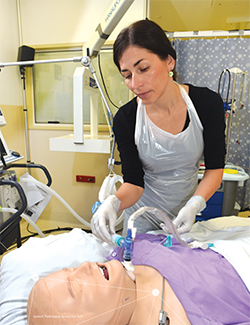Changing lives for critically ill patients

Speech Pathologist Anna-Liisa Sutt
Speech pathologist Anna-Liisa Sutt is challenging beliefs and changing practice through her research helping tracheostomised mechanically ventilated patients speak sooner.
Anna-Liisa received initial funding from The Prince Charles Hospital Foundation to start her project and in 2016 received an NHMRC Postgraduate Scholarship. The research looks at the effects of speaking valves on lung mechanics when used with tracheostomised patients requiring mechanical ventilation. She says speaking valves have not been traditionally used with these patients due to concerns about the possibility of lung collapse and extended ventilator weaning.
“This means tracheostomised ICU patients are left voiceless for a long time and are unable to verbally communicate with staff, family and friends. Other means of communication such as pen-paper, mouthing and pointing are less precise and cause a lot of frustration for patients and their communication partners,” Anna-Liisa says.
“There has been no physiological data published relating to the use of speaking valves with ventilated ICU patients, so the medical world is sceptical of their use in critically ill patients.”
Anna-Liisa’s research with the Critical Care Research Group (CCRG) has shown that speaking valves may actually be beneficial to the lungs when a patient is ventilated.
“It turns out the speaking valve helps to recruit the alveoli, rather than collapse them. We also found out that we often think we have understood the voiceless patient, where in fact, we haven’t,” she says.
“We found a significant discrepancy between patients’ and nursing staff ratings on patients’ success with health-related communication before they were using a speaking valve. Listening to the voiceless patient is certainly something we could be doing better.”
The research has been shared with speech pathologists and critical care colleagues in Australia and internationally where clinicians were keen to hear about Anna-Liisa’s findings.
“We now see 75 per cent of tracheostomised patientsvin our ICU able to talk and 70 per cent of these patients are still ventilated when they return to verbal communication,” she says.
“It has taken the efforts of the whole multidisciplinary team in ICU to change how we were doing things and everyone in ICU is excited to see more patients able to communicate. It makes looking after them a lot easier too if the patients can have a say in their care.
“Patients often report that being able to talk makes them feel like part of the human race again.”
